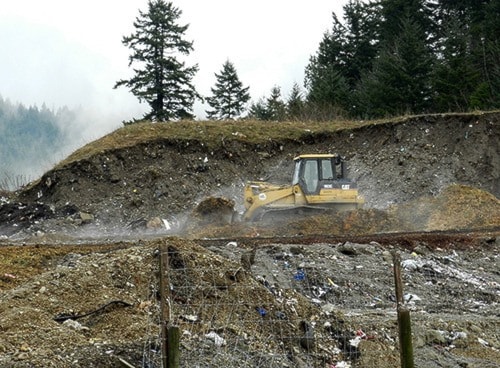Council has voted in favour of immediately closing the Hope landfill.
The decision is expected to reduce the costs of solid waste management and reduce the environmental impact of the landfill site. A presentation was given to council on Tuesday night, by Earl Rowe, former Town Manager. He was brought in to help create the report, along with CAO John Fortoloczky and Couns. Peter Robb and Scott Medlock.
With only 10 years left in the site's life-span, and years of controversy due to environmental concerns, the site's closure was imminent, according to the report. While it outlined three ways the district could keep operating the site, the report did recommend its closure.
There was an urgency for action, as the planned closure dovetails with a construction project taking place in Burnaby. Now that council has voted in favour (Coun. Medlock was absent), the plan will need approval from the Ministry of Environment and the Fraser Valley Regional District.
If approved, JJM Construction Ltd. will start hauling waste to the site on Mar. 1 in order to fill the site to capacity. That waste would come from Norampac Mill in Burnaby. It is expected that the transfer of waste from the mill to the landfill would take until the end of July, at a rate of 50 trucks and transfers per day.
There would also be a period of rock blasting, throughout March and April, as JJM prepares a quarry area and lining of an expansion area to enlarge the landfill capacity. The landfill is expected to be fully closed by Sept. 30 this year. JJM would bear the costs of the closure, and would provide rental income on the property.
There will be no disruption in service for customers, the report stated. First Class Waste would build and operate a transfer station, and Hope’s solid waste would be sent by rail to the Roosevelt Regional Landfill in Washington State.
One of the options to extend use of the facility to 2022 involves building an $8-million leachate treatment facility.
The landfill is located “in an unfortunate location on land” with a steep slope toward the Fraser River, and adjacent to First Nations land.
The site began as a “crude dump site” similar to those found in many small towns across the province. The district has run the site since 1974.
The current leachate treatment pond encroaches on Union Bar land, and last year Chief Andy Alex told media he has been trying for decades to have the landfill shut down.
In 2009, the Ministry of Environment sent the district a non-compliance notice. It cited issues such as lack of cover, lack of cells, excessive litter, poor surface water and ineffective leachate treatment.
The cost of maintaining the site, which serves 6,690 residents in 2,662 homes was $1,722,100 in 2011. The cost of continuing to maintain the site until 2022 (the site's previous expected life span) would total $8.4 million, plus closure costs of $25 million.
However, closing the site won’t stop the leaching, the report acknowledges. There will still be a need for treatment and monitoring, at a cost of $56,000 annually for 25 years. However, the district will save $400,000 a year by not operating a landfill site. In addition, the funds the district sets aside each year for permanent closure ($175,000) can be diverted to other infrastructure needs.
As it is today, the cost of collection would be covered by user fees and tax assessments.
Now that the report has been adopted, there are still several agencies that need to grant approval to the process. Both the Ministry of Environment and the Fraser Valley Regional District will need to grant approval to the plans, and contracts will need to be written.
The FVRD will need to approve the closure of the site and the hauling of the waste to Washington.
